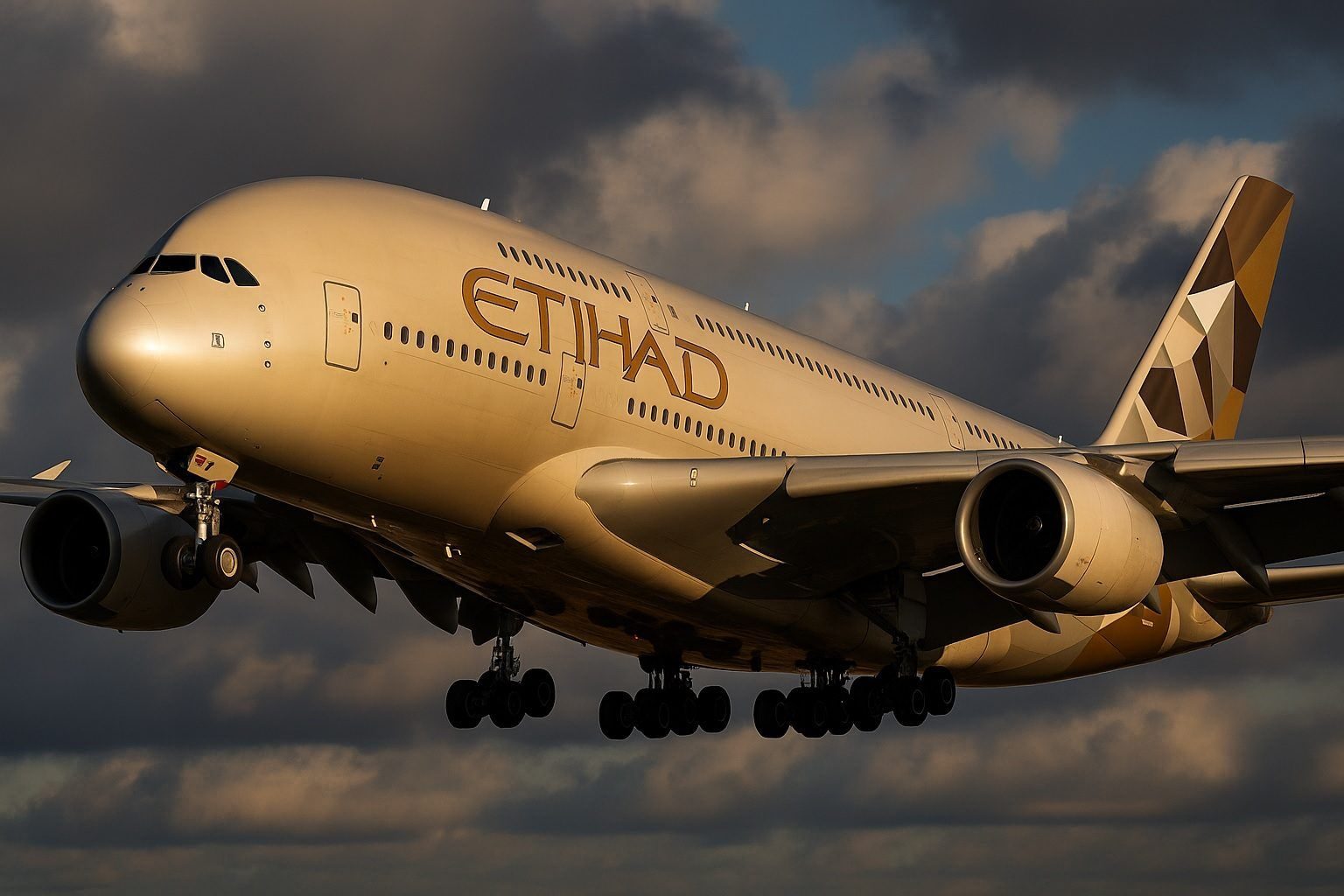On 25 November 2025, aviation and travel outlets around the world focused on one big network move: Etihad Airways is sending its flagship Airbus A380 to Tokyo Narita, adding Japan to the airline’s growing superjumbo network from 16 June 2026. [1]
The move will upgrade the daily Abu Dhabi–Tokyo Narita service from an Airbus A350-1000 to the double‑deck A380, significantly increasing capacity and bringing Etihad’s most premium-heavy aircraft – including its ultra‑luxury three-room “Residence” suite – to Japan for the first time. [2]
Key facts at a glance
- Route: Abu Dhabi (AUH) – Tokyo Narita (NRT)
- Aircraft: Airbus A380-800
- Start date: 16 June 2026 (northern summer 2026 season) [3]
- Frequency: Daily, year-round (currently scheduled through mid‑November 2026) [4]
- Replaces: Airbus A350-1000 on the route [5]
- Cabin layout: Four classes, up to 486 passengers including The Residence, First, Business and Economy (with extra‑legroom seats) [6]
What exactly has Etihad announced?
Etihad’s own press release on 24 November confirmed that its A380 will operate between Zayed Abu Dhabi International Airport and Narita International Airport from 16 June 2026, “in time for the busy summer travel season.” [7]
The announcement means Tokyo becomes the fifth city in Etihad’s A380 network, joining London Heathrow, Paris Charles de Gaulle, Singapore Changi and Toronto Pearson. [8] Follow‑up coverage on 25 November by outlets including Aerospace Global News, Travel Radar, TTN Worldwide and others reiterated the start date and highlighted that the upgrade is driven by sustained demand between the UAE and Japan, especially from business travellers. [9]
Indian daily The Tribune framed the move as the debut of Etihad’s A380 in Japan, noting that the aircraft’s arrival also marks the return of the airline’s eighth A380 from long‑term storage. [10]
Daily schedule: timings of the new A380 service
According to Etihad’s published schedule and route data collated by AeroRoutes, the A380 will operate once daily in each direction as follows (all times local): [11]
- EY800 – Abu Dhabi (AUH) → Tokyo Narita (NRT)
- Departs AUH: 21:25
- Arrives NRT: 12:45 (+1 day)
- EY801 – Tokyo Narita (NRT) → Abu Dhabi (AUH)
- Departs NRT: 18:00
- Arrives AUH: 00:20 (+1 day)
Several outlets, including Travel Radar and Aviation A2Z, have reproduced the same timings, confirming that the service is designed to maximise connections in both directions – evening departures from each hub leading into robust bank structures in Abu Dhabi and convenient afternoon arrivals into Tokyo. [12]
A major capacity and product upgrade for Tokyo
From A350-1000 to A380
Today, Etihad’s Abu Dhabi–Narita route is operated by the Airbus A350‑1000. From June 2026, that will be replaced by the much larger A380, a change that bloggers and analysts estimate will add well over 100 seats per flight, depending on final configuration. [13]
Commentary on frequent‑flyer site One Mile at a Time notes that the 5,035‑mile flight, already popular with both business and leisure travellers, will see “quite the capacity increase” as it moves from the twin‑engine A350 to the four‑engine superjumbo. [14]
Why Tokyo, and why now?
Across coverage on 24–25 November, Etihad executives consistently point to three reasons for the upgrade: [15]
- Strong demand between the UAE and Japan – driven by trade, investment and tourism flows.
- Premium‑heavy traffic – Tokyo is a high‑yield market where First and Business cabins perform well.
- Network strategy – deploying A380s only on trunk routes where they can be filled consistently and profitably.
Arik De, Etihad’s Chief Revenue and Commercial Officer, is quoted across multiple outlets describing Japan as a “favourite destination” for guests and emphasising the aircraft’s suitability for a market with deep economic and cultural ties to the UAE. [16]
Inside Etihad’s A380: four classes and The Residence
Several of today’s articles lean heavily into the onboard product story, because the A380 is the only Etihad aircraft to feature four distinct cabin classes. [17]
The Residence – a three-room suite in the sky
At the very top is The Residence, widely billed as the only three‑room suite available on a commercial airline: [18]
- Private living room, separate bedroom and ensuite bathroom with shower
- Space for up to two guests
- Dedicated crew providing highly personalised service, including dining on designer tableware and options like champagne, caviar and signature afternoon tea
Analysts expect Etihad to continue its current strategy of selling upgrades into The Residence from paid First Class tickets, rather than offering it as a standalone fare costing tens of thousands of dollars as in the pre‑pandemic era. [19]
First Class Apartments
Just behind The Residence are nine First Class Apartments, each with: [20]
- A large leather armchair
- A separate ottoman that converts into an 80‑inch fully flat bed
- A personal vanity unit
- Access to a dedicated First Class shower room
This layout has long been considered one of the most spacious first‑class products in the sky, a point echoed in today’s commentary from frequent‑flyer media. [21]
Business Studios and The Lobby
On the upper deck, Etihad offers 70 Business Studios, the same basic seat design used on its Boeing 787s, arranged to maximise direct aisle access and privacy. [22]
Business and First passengers also share The Lobby, a staffed lounge and bar space where small groups can socialise, work or simply stretch out away from their seat during the long sectors to and from Japan. [23]
Economy Smart Seats with extra legroom options
The entire lower deck is devoted to Economy, split between: [24]
- 68 extra‑legroom seats, offering around four inches more pitch
- 337 Economy Smart seats, with fixed‑wing headrests and larger pillows
Different outlets quote slightly different total seat counts (some suggest 485–486 seats), but the underlying configuration – four classes including The Residence, plus a mix of standard and extra‑legroom economy – is consistent across reporting and the airline’s own description. [25]
Etihad’s evolving A380 strategy: from near-retirement to network centrepiece
A big theme in today’s coverage is how far Etihad has pivoted from its early‑pandemic position that the A380 was “too big” and unlikely to return. [26]
From storage yards back to flagship routes
According to Aerospace Global News, Etihad originally took delivery of 10 A380-800s between 2015 and 2017, before grounding the fleet in 2020. [27] Since 2023, the airline has gradually reactivated the type:
- 2023: A380s return on Abu Dhabi–London Heathrow
- 2024: Superjumbo resumes New York JFK (and later shifts to Toronto)
- Late 2024–2025: Network expands to Paris Charles de Gaulle and Singapore Changi [28]
By reactivating an eighth A380 for the Tokyo route, Etihad signals further confidence in using the type on a handful of dense, high‑yield corridors. The carrier has previously indicated plans to bring a ninth A380 back into service by 2027, while the tenth frame is being dismantled in Spain. [29]
Five A380 destinations in 2026
Simple Flying’s A380 network analysis – promoted today under the headline “More Aircraft, More Routes” – and other trade coverage agree that in 2026 Etihad’s A380s are expected to operate on five main routes: London, Paris, Singapore, Toronto and Tokyo Narita, all from Abu Dhabi. [30]
Rather than trying to deploy the double‑deckers everywhere, Etihad is clearly concentrating them where they can deliver the biggest commercial and brand impact – and Tokyo, one of the world’s largest and most premium‑heavy markets, fits that mould.
What the A380 means for travellers between Japan and the UAE
For passengers, the upgrade is about more than aviation nostalgia or aircraft spotting.
More seats, more choice
With the A380 replacing the A350‑1000, capacity on the route jumps significantly, which: [31]
- Makes award seats and upgrades more attainable for frequent flyers
- Increases economy‑class availability during peak travel periods
- Supports higher volumes of tourist and business traffic in both directions
Gulf‑based outlets highlight that Japanese travellers will gain easier access not only to Abu Dhabi but also to Etihad’s wider network across the Middle East, Europe and Africa via same‑day connections. [32]
A new premium option for Japan-bound flyers
For premium travellers from Europe, the Middle East and Africa heading to Tokyo, the route will offer: [33]
- A rare chance to fly The Residence to Japan
- One of the most spacious First Class hard products currently scheduled to Narita
- A competitive Business Class and refreshed soft product that industry reviewers have praised in recent months
That combination is likely to appeal to both corporate accounts and high‑spending leisure travellers – exactly the segments Etihad is targeting with its renewed A380 strategy.
Why this story matters today (25 November 2025)
On 25 November 2025, the Etihad A380–Tokyo Narita announcement has become one of the day’s standout aviation stories, with fresh analysis and updates from:
- Aerospace Global News, focusing on fleet strategy and the reactivation of the eighth A380 [34]
- Travel Radar, highlighting flight timings and the broader A380 network [35]
- TTN Worldwide and other travel‑trade titles, framing the move in terms of tourism flows and premium demand between Japan and the UAE [36]
- Enthusiast and frequent‑flyer sites such as One Mile at a Time, which dig into product details, upgrade possibilities and the bigger narrative of the A380’s unlikely comeback [37]
Taken together, today’s reporting paints a clear picture: Etihad is doubling down on the superjumbo where it makes the most sense, and Tokyo Narita – soon to be linked daily to Abu Dhabi by one of the world’s most distinctive aircraft – sits right at the heart of that strategy.
References
1. www.etihad.com, 2. onemileatatime.com, 3. www.etihad.com, 4. www.aeroroutes.com, 5. onemileatatime.com, 6. www.etihad.com, 7. www.etihad.com, 8. www.etihad.com, 9. aerospaceglobalnews.com, 10. www.tribuneindia.com, 11. www.etihad.com, 12. travelradar.aero, 13. onemileatatime.com, 14. onemileatatime.com, 15. www.etihad.com, 16. www.etihad.com, 17. www.tribuneindia.com, 18. www.etihad.com, 19. onemileatatime.com, 20. www.etihad.com, 21. onemileatatime.com, 22. www.etihad.com, 23. www.etihad.com, 24. www.etihad.com, 25. www.etihad.com, 26. aerospaceglobalnews.com, 27. aerospaceglobalnews.com, 28. onemileatatime.com, 29. aerospaceglobalnews.com, 30. simpleflying.com, 31. www.facebook.com, 32. gulfnews.com, 33. www.etihad.com, 34. aerospaceglobalnews.com, 35. travelradar.aero, 36. www.ttnworldwide.com, 37. onemileatatime.com










